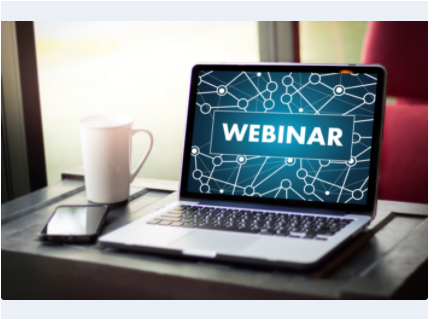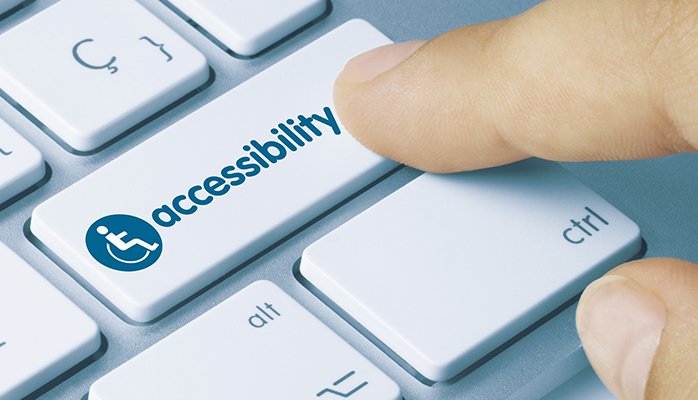Global Accessibility Awareness Day is May 18th. Events focused on the mission of accessibility awareness are already in full swing. At UsableNet, we are proud to participate in several GAAD events, both in-person and virtual.
Save your seat for our GAAD webinar on company culture and digital accessibility.
Any Global Accessibility Awareness Day celebration should, of course, be accessible to people of all abilities. If you are putting the finishing touches on planning your GAAD event, here are a few things you can keep in mind for an inclusive event.
1. Ask your attendees about accommodations.
Asking ensures you realize if there is anything you need to look into accessibility-wise in your event planning. It also shows you that you care.
Speaking of showing that you care, on our webinar confirmation page, we state the accommodations we have in place proactively. For instance, we confirm that our webinars will use a platform that is WCAG 2.1 compliant and that we can offer real-time captions.
Asking can be as simple as including a statement on event confirmation like this one,
" If you require a reasonable accommodation to participate in this event, please contact ____________ [insert: the sponsoring department or contact person] at [insert: telephone number, email, fax number]."
2. Appoint a contact person.
There can be many people involved in event planning. It may be a good idea to ensure one designated person is responsible for accessibility. This person should facilitate requests for accommodations and works to solve any unforeseen accessibility issues that occur. We typically list this contact on the confirmation page and in confirmation emails.
3. Train your event staff.
Your staff is the best representative of your company and culture. So, while you may have a designated contact, your staff should have training on accommodations, assistive devices, and etiquette. For instance, it's always inappropriate to grab someone's wheelchair without consent, even if you are "helping" them.
4. Check that your event communication is accessible.
Ensure that your webinar registration page follows WCAG. Many times, we use the same template that is tested for and update it. If you take this approach, ensure your font and color customizations don't negatively impact accessibility.
Check the accessibility of your confirmation emails. Any other communications to attendees should go through an accessibility check. See this blog on email communication best practices.
5. Share your slides ahead of time.
With last-minute changes, this is only sometimes possible. However, if you can provide slides ahead of time, it can benefit everyone. Reviewing your slides beforehand may help attendees better follow your presentation and help them prepare and plan to participate in your Q&A.
6. Keep your presentation simple and easy to read.
You want to avoid:
complex infographics and charts that may be difficult to understand,
visual clutters on your slides
long sentences, or too much text.
Avoiding complicated slides will make it easier to describe them; you should provide a brief audio description of each slide while presenting to help people with visual disabilities who may be listening. Descriptions also help folks who can only participate by dialing in for various reasons.
Your slides should use the following:
precise language,
clear fonts,
white space,
and good color contrast between your text and background.
Plan to provide your slides after, if not in a deck, then in a pdf remediated to be compatible with assistive technology.
7. Use captions.
Are you using video during your presentation? Make sure you get it captioned.
If you are producing a webinar, get live captioning. At UsableNet, we don't rely on automated captions. We use Zoom and its manual caption feature and book an experienced captioner. Still, suppose automated captions are your only choice due to resource constraints. In that case, automated captions are better than none and are becoming more sophisticated.
Captions can be critical to people with auditory disabilities and cognitive disabilities. They are helpful to people with temporary/situational disabilities, multilingual users, and everyone who prefers to view videos and webinars with captions.
Captions are not just for webinars. Large screens at physical events make captions possible. For physical events, showing the presenter on the screen along with captions allows for lip reading. At events like the CSUN Assistive Technology Conference in Anaheim, California, ASL interpreters are on stage and in the audience should attendees request this accommodation.
8. Choose an accessible webinar platform.
An accessible platform should allow you to provide your attendees with captions, but it should also allow for more than that. A few questions to ask include:
Can attendees customize the font size of the chat and captions?
Can attendees navigate with just a keyboard?
Does your provider offer screen reader support?
Ideally, you'll want to use software tested by people with disabilities that complies with WCAG standards.
9. Think about inclusion when selecting a physical event space.
Emily Ladau is a Disability Rights Activist and Author of Demystifying Disability: What to Know, What to Say, and How to be an Ally. She recently shared in a Linkedin post for Mental Health Awareness Month an experience where she was asked to speak at a work event. Unfortunately, while the event and facility were technically accessible, her experience was not inclusive.
In Ladau's telling, the only entrance to accommodate her wheelchair was past the garbage. Later at the same event, there was a reception, but Ladau could not join the group because they had gathered in an inaccessible area below a large step. She had to sit in the corner alone. From this account, it sounds like the room selected for the event technically met the physical requirements for accessibility. Unfortunately, due to the event setup, she was excluded.
10. Speak slowly, and clearly, and provide context.
Remember your captioner? You want to speak slowly enough that they can keep up with you. Try to articulate your words more than you usually would. If you keep this in mind, it will again benefit people with auditory disabilities, cognitive disabilities, temporary/situational disabilities, and multilingual users.
Using a microphone can improve sound quality and your attendees' experience, whether in person or at an online event.
During the Q&A, you may get questions relevant to your presentation earlier. Frame them so they are easy to follow. And, rather than launching into the answer, please repeat the original question if people on the call cannot view it.
Accessibility makes events better!
An inclusive event, whether virtual, in-person, or hybrid, makes the event better for everyone. Think how much better an event you worked hard to coordinate will be if everyone, including your speakers, can participate equally. If you are planning an event next week or any time, we hope these best practices are helpful.
Interested in joining UsableNet for our Global Accessibility Awareness Day event? On May 17th, join us for a webinar hosted by Jeff Adams, Director of Accessibility Operations, at 12 pm ET.
Save your seat for our May 17 webinar,
How to Create a Culture of Digital Accessibility*
*UsableNet webinars are eligible for 1 Continuing Accessibility Education Credit (CAEC) for those who are Certified Professional in Accessibility Core Competencies (CPACC) and Certified Professional in Web Accessibility (CPWA) by the International Association of Accessibility Professionals (IAAP).






